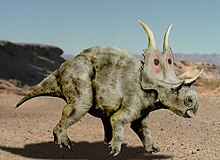Diabloceratops
| Diabloceratops | ||||||||||||
|---|---|---|---|---|---|---|---|---|---|---|---|---|

Schädel von Diabloceratops (rechts), links oben der Schädel von Nasutoceratops | ||||||||||||
| Zeitliches Auftreten | ||||||||||||
| Oberkreide (Unteres und Mittleres Campanium)[1] | ||||||||||||
| 83,6 bis 76,4 Mio. Jahre | ||||||||||||
| Fundorte | ||||||||||||
| Systematik | ||||||||||||
| ||||||||||||
| Wissenschaftlicher Name | ||||||||||||
| Diabloceratops | ||||||||||||
| Kirkland & DeBlieux, 2010 | ||||||||||||
| Art | ||||||||||||
| ||||||||||||
Diabloceratops (von altgriechisch Διάβολος Diábolos ‚Teufel‘, κέρας kéras ‚Horn‘ und ὤψ ōps ‚Antlitz‘; wörtlich also „Gesicht mit Teufelshörnern“) war eine Gattung von Vogelbeckendinosauriern (Ornithischia) aus der Gruppe der Ceratopsia. Der herbivore Diabloceratops lebte in Nordamerika, wo er 2002 in der Wahweap-Formation im Gebiet des Grand Staircase-Escalante National Monument im US-Bundesstaat Utah entdeckt wurde. Das Holotyp-Exemplar besteht aus einem nahezu vollständig erhaltenen Schädel. Ein weiterer fragmentarischer Schädel könnte ebenfalls zu dieser Gattung gehören.

Merkmale
Diabloceratops erreichte eine Länge von etwa 3,5 Metern und eine Höhe von 1,2 Metern. Auffälligstes Merkmal ist sein mit Halskrause und gebogenen Hörnern besetzter Schädel, dem er seinen Namen verdankt.
Systematik
| ||||||||||||||||||||||||||||||||||||||||||||||||||||||||||||||||||||||||||||||||||||||||||
| Systematische Stellung von Diabloceratops nach Evans & Ryan (2015). |
Diabloceratops zählt zu den Ceratopsidae. 2015 wurde der Stammbaum der Centrosaurinae von Evans & Ryan (2015) anlässlich der Erstbeschreibung des in Kanada gefundenen Wendiceratops überarbeitet. Demnach stellt Diabloceratops die basalste Gattung und das Schwestertaxon aller anderen bekannten Centrosaurinae dar, gefolgt von einem gemeinsamen Taxon aus Nasutoceratops und Avaceratops.[2] Bei einer phylogenetischen Analyse 2012 wurde Xenoceratops noch als basalste Gattung der Centrosaurinae betrachtet und allen anderen bekannten Gattungen einschließlich des Diabloceratops gegenübergestellt.[3]
Literatur
- James I. Kirkland, Donald D. DeBlieux: New basal centrosaurine ceratopsian skulls from the Wahweap Formation (Middle Campanian), Grand Staircase-Escalante National Monument, southern Utah. In: Michael J. Ryan, Brenda J. Chinnery-Allgeier, David A. Eberth: New Perspectives on Horned Dinosaurs. The Royal Tyrrell Museum Ceratopsian Symposium. Indiana University Press, Bloomington IN u. a. 2010, ISBN 978-0-253-35358-0, S. 117–140, Digitalisat.
Einzelnachweise
- ↑ Gregory S. Paul: The Princeton Field Guide To Dinosaurs. Princeton University Press, Princeton NJ u. a. 2010, ISBN 978-0-691-13720-9, S. 258, Online.
- ↑ David C. Evans, Michael J. Ryan: Cranial Anatomy of Wendiceratops pinhornensis gen. et sp. nov., a Centrosaurine Ceratopsid (Dinosauria: Ornithischia) from the Oldman Formation (Campanian), Alberta, Canada, and the Evolution of Ceratopsid Nasal Ornamentation. PLOS ONE 10 (7): e0130007. doi:10.1371/journal.pone.0130007.
- ↑ Michael J. Ryan, David C. Evans, Kieran M. Shepherd: A New Ceratopsid from the Foremost Formation (Middle Campanian) of Alberta. In: Canadian Journal of Earth Sciences, Bd. 49, Nr. 11, 2012, ISSN 0008-4077, S. 1251–1262, doi:10.1139/e2012-056.
